| |
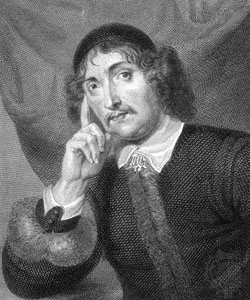
James Shirley (1596-1666)
Poet and dramatist, b. in London, 18 Sept., 1596; d. there
Oct., 1666. As a boy he attended the Merchant Taylors School,
from October, 1608, to June, 1612, matriculating at St. John's
College, Oxford, in the latter year; he there won the esteem
of Laud, the president of the college. In 1617 he took his degree
of B.A. at St. Catherine's Hall, Cambridge, and soon after taking
orders in the English Church (1619), was assigned curate in a
parish near St. Albans, where he remained until his conversion
to the Catholic Church. After his conversion he taught for a
livelihood and became master in the Edward VI School at St. Albans,
on the failure of which he removed to Gray's Inn, London, 1625,
as he said "to set up for a play maker". That he was
faithful in the practice of his religion is gleaned from his
works. His praise of the Benedictines in the "Grateful Servant"
betrays an intimacy with the monks of that order. His first poem,
"Eccho or the Infortunate Lover", appeared in 1618.
There is no known copy of this under that title but it is supposed
to be identical with "Narcissus or the Self Lover",
still extant, which was published in 1616 and is an evident imitation
of "Venus and Adonis". The beginning of his literary
career was coincident with the accession of Charles I, who was
enthusiastic over his comedy "The Gamester" and is
even said to have suggested the plot. Shirley was a loyalist
as evidenced by his poem on "The Prince's Birth", 1630,
and he received great encouragement from Queen Henrietta Maria.
His "Maide's Revenge" (1639), however, shows him to
have been no lover of court flattery. He enjoyed great popularity
as a playwright, and before 1640 he produced over thirty plays.
"Love's Tricks" (1631) was the first, followed by:
"The Traitor", a tragedy (1635); "Hyde Park",
comedy (1637); "The Gamester", comedy (1637); "The
Royal Master", sentimental comedy (1638); "The Ball",
comedy, in collaboration with Chapman (1639).
During the plague in London (1636-37), when the theatres were
closed there, the dramatist went to Dublin, probably under the
patronage of George Fitzgerald, 16th Earl of Kildare, to whom
he dedicated "The Royal Master". Here he produced three
or four plays, among them "St. Patrick for Ireland"
and "The Royal Master", in Ogilby's Theatre (built
in 1635), the first public theatre in Ireland. He returned to
England a few years before the revolution in 1642 when the Long
Parliament ordered all the theatres closed. From Nov., 1642,
to July, 1644, Shirley fought under the Duke of Newcastle, to
whom, in gratitude for former kindness, he had dedicated his
tragedy "The Traitor" (1635). On the decline of the
king's fortune he returned to London and his old occupation of
teaching at the academy in Whitefriars, numbering among his students
many afterwards eminent men. For these pupils he wrote several
text-books, among them: the "Via ad latinam linguam complanata",
with rules "for the greater delight and benefit of readers
in both English and Latin Verse"; "Rudiments of Grammar"
with rules in English verse.
However, the attraction of the theatre was too strong and
he soon returned to the composition of plays. In 1646 he wrote
"The Triumph of Beauty", on the familiar theme of Peele's
"Arraignment of Paris", and "The Contest of Ajax
and Ulysses". In the latter is found the now famous dirge
beginning "The glories of our Mortal State are shadows,
not substantial things", which is said to have terrified
Oliver Cromwell. "The Cardinal", his masterpiece in
tragedy, appeared in 1652, followed in 1653 by "Six Newe
Plays" and in 1655 by two more. In a preface to a work in
1659 he informed his readers that this is "likely to be
the last of his dramatic productions" and he held to this
resolution. Driven from his home in Fleet Street during the great
fire of London, 1666, he took refuge in the parish of St. Giles
where he and his wife died on the same day, survived by three
sons and a married daughter. They were buried in the Church of
St. Giles-in-the-Fields, 29 Oct., 1666.
James Shirley was the last of the great Elizabethan dramatists
linking the Golden Age with the period of the Restoration. Though
at times original in the invention of his plot, which was always
ingenious and interesting, his mind was not that of a great master
opening up new and untried ways. He was rather a diligent student
and painstaking imitator of his great contemporaries and predecessors.
He was an honour student in a school of which Shakespeare, Massinger,
and Fletcher chiefly were the masters. He owes more to Fletcher
perhaps than to any other; but he is often also reminiscent of
Shakespeare. A critic said of him that what he borrowed from
others lost nothing in his hands. He borrowed characters, situations,
and ideas, but the manipulation of them was his own as was also
the poetic language which enriched them. He numbered among his
friends such men as Massinger, Ford, and Habington; his admiring
imitators are found for two centuries after his death. "The
Gamester" was frequently adapted by Garrick in 1758 and
1773, and by Poole in "The Wife's Strategem" in 1827.
He was quick to observe the follies of his time and his pen was
facile in delineating them. He is often reminiscent of Shakespeare,
as when he introduces into one of his masques an imitation of
the famous comic portion of a Midsummer Night's Dream where the
shepherd "Bottle" takes the place of Bottom the Weaver.
His tragedy "The Politicians" brings back memories
of Hamlet. With the exception of Shakespeare no dramatist knew
better than he how to enhance his narration with striking images
or to intersperse his dialogues with poetic passages of rare
workmanship, while he was far in advance of his day in grasping
the idea of making the whole play centre in one striking scene
(la scène à faire). Splendid examples of this may
be seen in the three classes of drama in which he exercised his
pen, in the tragedies, "The Traitor" and "The
Cardinal", in the tragi-comedy, "The Royal Master",
and in his comedy "The Gamesters". If lacking in pathos
or in deep knowledge of the human heart, he possesses one quality
not prevalent in the writings of his contemporaries. His plays
are clean morally, and of "The Young Admiral", a romantic
comedy licensed 3 July, 1633, we read that it was fit to serve
"for a patterne to other poetts not only for the bettring
of manners and language, but for the improvement of the quality
[i.e., the actors] which hath received some brushings of late".
The plays of Shirley, once produced in the famous cockpit at
Drury Lane, are preserved for us in the only complete edition
of his works ever made and edited by Gifford and Dyce (6 vols.,
London, 1833). The revival of interest in his dramas is due to
the sympathetic criticism of Charles Lamb.
WOOD in Athenae Oxonienses, ed. BLISS, III (London, 1817),
737-44; FLEAY, Biographical Chronicle of the English Drama (London,
1891); WARD, History of English Dramatic Literature (London,
1875); Quarterly Review, xlix (April and July, 1833); CIBBER,
Lives of the Poets (London, 1753); WARD in Dict. Nat. Biog.,
s. v.
WILLIAM DEVLIN
Transcribed by Herman F. Holbrook
For the glory of God and in honor of Saint Philomena.
The Catholic Encyclopedia, Volume XVI (Index Volume)
Copyright © 1914 by The Encyclopedia Press, Inc.
|
| |
|
Lineage of James Shirley, English Dramatist
The Baptism records of James Shirley (the poet), appear
in the registers of St. Mary Woolchurch, London, for September
7, 1596. A son of James told a chronicler of the seventeenth
century, that his fathers birthplace was "where the Stocks
mark now is". Several major streets converged at the spot...
Poultry, Cornhill, Lombard and Threadneedle. (This area is about
4 or 5 blocks behind St. Pauls Cathedral).
William Shirley of St. Mary Woolchurch,
City of London
The Shirley records of St. Mary Woolchurch begin with William
Shirley, the grandfather of James Shirley the poet. A William
Shirley married Marie Newton November 11, 1561 in the nearby
church of St. Mary le Bow and is believed to be the William of
St. Mary Woolchurch. (Summer of 2000 I walked to St. Mary le
Bow...about 2 blocks from St. Pauls, and took pictures). By 1564,
William and his wife were living in a house belonging to the
parish of Woolchurch and paid a rent of $4 pounds per year; in
addition, he paid 13/4d. for a little house or "tenement"
adjoining. The following year he contributed for the "Good
Wiff Wilson's house" in the amount of 5s. and for each year
until his death. William Sherley is listed in the church records
for paying 6/8 to have ground broken for burial of his maid.
In 1571 he along with several others in the parish was involved
in a court case about his rented house. The suit was brought
by Thomas Jenkinson who claimed various lands from the church.
The suit fees were paid by the church. In 1577, William Sherley
won election to the post of churchwarden. During the next decade
his signature appeared regularly among those approving the accounts.
William Sherley called himself "citizen and draper of London".
The drapers had been granted a monopoly for the retail of cloth
as early as 1364. In time these merchants came to sell nearly
everything. The drapers were located in Candlestick and Watling
Streets...an area merging into the Stocks Market about one hundred
yards north. William Shirley died in 1593
married _______
children (There may be others?)
1(i). Thomas Shorley - April 25, 1566 St. Mary Woolchurch.
In 1586 he was entered in the Freedom list of the Drapers Co.
married ______
children:
2(i). Elizabeth Sharlie - chr 29 Jun 1590 St. Mary
Woolchurch, daughter of Thomas Sharlie
1(ii). un-named Sharlie died in Nov 1566
1(iii). James Sharlie - chr January 18, 1568 St. Mary
Woolchurch (father of James Sherley the poet, see next). He was
buried there June 2, 1617. Wills in Commissary Court of London
(London Division), Vol III 1571-1625, James Sherlie, St. Mary
Woolchurch, admon 16, 2734.
When his father died in 1593, church and guild records indicate
James carried on his father's house and business. He continued
to be associated with the drapers. Quarterage and account books
began in 1605 and entries for James Sherley, Stockes, James Shorley,
Woolchurch appears in those books until 1613. Another listing
in the books shows James Shorley from 1605 until 1616, a notation
after 1616 is written "Katherine Shorley his widowe".
In a separate quarterage book, a notation for 1617 is written
"Widdow Sherley of James Sherley of Woolchurch".
Roger Highewaye was bound to Katherine Shirley for eight years.
Roger was the son of Thomas Highewaye, cordwainer, describes
Katherine Shirley as a free-woman adn late wife of James, "haber
of small wares by the Stocks". (A haberdasher was the proprietor
of a small notions shop selling hat, books, etc.). Apparently
she remarried as her name is given as Catherine Chatwyn als.
Sharley, of the parish of St. Botolph without Aldgate in London
,as revealed in her son James Shirley's license to marry in 1618.
There is a burial entry of May 26, 1627 for Katheryne Chetwyn,
widow, in St. James, Clerkenwell parish, near St. Andrew's, Holborn,
where James Shirley resided about that time.
married Catherine ______
Roger Highewaye was bound to Katherine Shirley for eight years.
Roger was the son of Thomas Highewaye, cordwainer, describes
Katherine Shirley as a free-woman and late wife of James, "haber
of small wares by the Stocks". (A haberdasher was the proprietor
of a small notions shop selling hat, books, etc.). Apparently
she remarried as her name is given as Catherine Chatwyn als.
Sharley, of the parish of St. Botolph without Aldgate in London
,as revealed in her son James Shirley's license to marry in 1618.
There is a burial entry of May 26, 1627 for Katheryne Chetwyn,
widow, in St. James, Clerkenwell parish, near St. Andrew's, Holborn,
where James Shirley resided about that time.
children: (could there be other children?)
2(i). James Shirley, poet and playwright, - chr Sept
7, 1596 St. Mary Woolchurch, London, died 1666
[note: the main source for Shirley's family history is
Wood in the 1690s apparently from conversations he had with the
poet's "son" who was Butler at Furnivalls Inn at Holborn
Middlesex. It's not known which of Shirleys sons with whom Wood
communicated]
married 1) Elizabeth Gilmet in 1618 St. Stephens, St.
Albans, Herts, daughter of Richard Gilmet, draper and merchant,
who served as mayor of St. Albans in 1607 and 1618. Richard Gilmet,
gent. and James Sherley posted surety in the amount of $100 pounds.
married 2) Frances Blackburne, She died 1666 (no children
by Frances)
children:
3(i). Marie Shirley - chr Dec 27, 1619 St. Albans Abbey,
Herts.
3(ii). Grace Shirley - chr May 15, 1622 St. Albans
Abbey, Herts.
3(iii). Mathias Shirley - chr. Feb 26, 1624 St. Giles
Cripplegate parish, London. Not much is known about him. He was
granted a pass to go to Holland in 1655. A Mathias Shirley appears
in Yorkshire at this time.
3(iv). Thomas Shirley - chr Sept 17, 1628 St. Andrew,
Holborne, Middlesex , buried Sept 22, 1634
3(v). John Shirley - chr May 11, 1631, St. Andrew,
Holborne, Middlesex
3(vi). Mary Shirley - chr May 26, 1633 Holborne, Middlesex,
died August 1, 1633 (same year).
3(vii). Mary Shirley
married Standardine Sachell, alias Shirley. In the
Will of Standardine Shirley... Oct 7, 1678, he does not mention
his name Sachell. He refered to himself as "gent" and
does not mention that he was a barber surgeon. He gives to the
poor of three parishes...Whitefriars, Islington, and Clerkenwell.
He bequeaths rings and money to Christoper and James Shirley,
whom he names as his brother-in-laws. He mentions James Shirley
the younger who he gave $20 pounds and for him to enter apprentice
school when came of age. Standardine made a good living from
his profession of Barber-surgeon. It was an occupation that attracted
many Catholics. This profession did not require a university
degree. Catholics were not granted degrees from these universities.
children:
4(i). George Shirley, alias Sachell
3(viii). Christopher Shirley (see St. James, Clerkenwell,
Middlesex) He was apprenticed to Standardine Shirley. Admitted
to his freedom in the company Barber Surgeons April 3, 1666.
In his will dated Jan 29, 1697, he states he is a barber-surgeon
and is of the parish of St. Andrew, Holborn, Middlesex. He bequeaths
$80 pounds to his niece, Eliz. Whitehead, and to his other niece,
Sarah Shirley, $20 pounds.
3(ix). James Shirley - chr about 1645. He was apprenticed
to Standardine Shirley in 1653. He gave testimony in a Chancery
Court case on June 1, 1685. He gave his address as Stonecutter
Steete in Shoe Lane in the parish of St. Brides London. He noted
he was a barber and was about 40 years of age.
married Susan Tempest on Nov 27, 1666 by Banes at St
Dunstan in West, Middlesex
children:
4(i). Standardine Shirley chr. 23 Jan 1669 at St Dunstan
in West ; buried 2 Sep 1670 at St Dunstan in West
4(ii). Mary Shirley chr. Aug 15 1671 at St Dunstan
in West.
3(x). Lawrinda Shirley - She married Edward Fountain.
She died before her father
2(ii). Ellen Shirley - chr 1 May 1598 St. Mary Woolchurch,
daughter of James Sharlie
2(iii). Elizabeth Shirley - chr 1599
2(iv). William Shirley - chr 15 Dec 1601 St. Mary Woolchurch,
son of James Sharlie
2(v). Mary Shirley - chr 4 Mar 1604 St. Mary Woolchurch,
daughter of James Sharlie; She died 1606
1(iv). Bridget Sharlie - chr 3 July 1569 St. Mary Woolchurch
daughter of William Sharlie. She died infant
1(v). Elizabeth Shirley - chr 20 Nov 1571 St. Mary
Woolchurch daughter of William Sharlie. She died infant
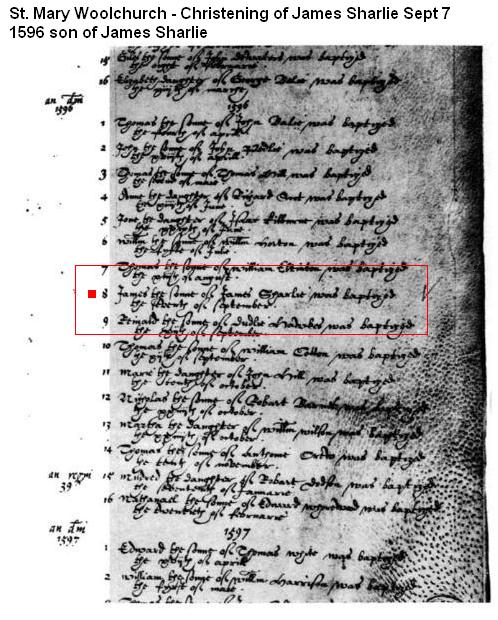
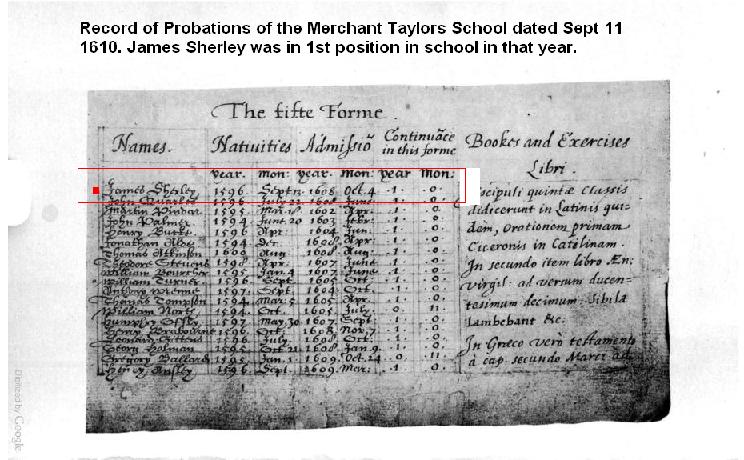
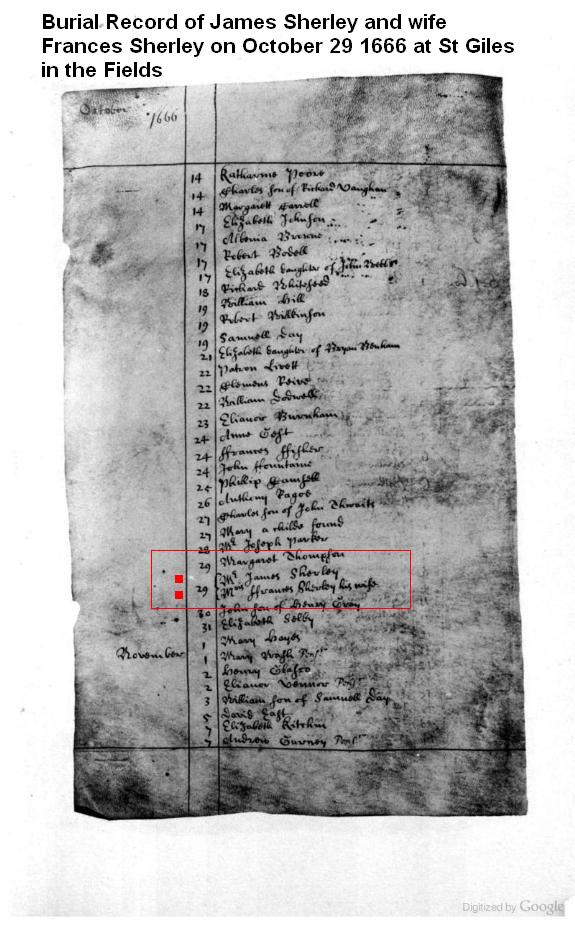
|


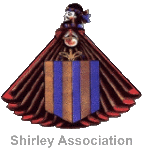
 James Shirley
James Shirley